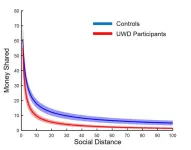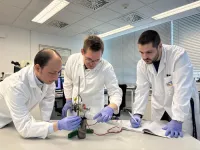(Press-News.org) Embargoed for release until 5:00 p.m. ET on Monday 14 April 2025
Follow @Annalsofim on X, Facebook, Instagram, Threads, and LinkedIn
Below please find summaries of new articles that will be published in the next issue of Annals of Internal Medicine. The summaries are not intended to substitute for the full articles as a source of information. This information is under strict embargo and by taking it into possession, media representatives are committing to the terms of the embargo not only on their own behalf, but also on behalf of the organization they represent.
----------------------------
1. One firearm injury was treated every 30 minutes in emergency departments in a study of 10 jurisdictions
Abstract: https://www.acpjournals.org/doi/10.7326/ANNALS-24-02874
URL goes live when the embargo lifts
A cross-sectional analysis of firearm injury-related emergency department (ED) visits found that between 2018 and 2023, there was approximately one firearm injury ED visit every 30 minutes in the 10 jurisdictions studied. The analysis also found that rates of firearm related ED visits were often highest during evenings, weekends, holidays and the summer months. According to the authors, this is the largest analysis to date of detailed temporal patterns in firearm injury using ED data. The results are published in Annals of Internal Medicine.
Researchers from the Centers for Disease Control and Prevention (CDC) analyzed trends in firearm injury ED visits between 1 January 2018 and 30 August 2023 using data from the CDC’s Firearm Injury Surveillance Through Emergency Rooms program (FASTER). They analyzed data obtained from nine states (Florida, Georgia, New Mexico, North Carolina, Oregon, Utah, Virginia, Washington and West Virginia) and the District of Columbia. They calculated the rates of firearm injury ED visits per 100,000 total ED visits and assessed temporal variations by time of day, day of the week, month and U.S. public holidays or other days of interest (e.g. Independence Day and Superbowl Sunday). The researchers found that across the 5-year period, the overall rate of firearm injury ED visits was 73.9 per 100,000 ED visits with a total of 93,022 firearm injury ED visits identified. These results equal approximately one firearm injury ED visit every half hour.
The researchers also noted that the rate of firearm injury ED visits gradually increased from the afternoon into the night and hit their average nightly peak rate between 2:30 am and 3:00 am. The average daily rates were highest on Friday, Saturday and Sunday. The daily rate of firearm injury ED visits was highest on New Year’s Eve (31 December), and the monthly rate was highest in July. Other holidays with high rates of firearm injury ED visits compared to non-holidays included Independence Day, Memorial Day weekend and Halloween. These findings highlight significant temporal clustering of firearm injury ED visits, and these insights could inform health care staffing and emergency preparedness, potentially reducing mortality rates associated with firearm injuries. While the researchers acknowledge that these data are not nationally representative, they note that understanding the factors behind the identified temporal patterns of firearm injury can help inform future prevention efforts and programs.
Media contacts: For an embargoed PDF, please contact Angela Collom at acollom@acponline.org. To contact corresponding author Adam Rowh, MD, please email media@cdc.gov.
----------------------------
2. More adults now use tirzepatide and semaglutide over conventional glucose and weight lowering medications
Abstract: https://www.acpjournals.org/doi/10.7326/ANNALS-24-02870
URL goes live when the embargo lifts
A population-based cohort study measured trends in use of tirzepatide versus other glucose-lowering medications (GLMs) and weight-lowering medications (WLMs) after tirzepatide’s FDA approval. The study found that dispensations of tirzepatide for both type 2 diabetes (T2D) and weight loss increased sharply after its entry into the U.S. market, whereas use of conventional GLMs (e.g., metformin and insulin) and WLMs (e.g., phentermine) declined. These findings highlight the rapidly shifting landscape of prescribing patterns for GLMs and WLMs. The study is published in Annals of Internal Medicine.
Researchers from Harvard University studied data from two cohorts of commercially insured adults with and without T2D taking GLMs or WLMs between January 2021 and December 2023. The researchers aimed to describe trends in pharmacy dispensing claims for GLMs among adults with T2D and for WLMs in adults without diabetes. GLMs examined included metformin, sodium–glucose cotransporter-2 inhibitors (SGLT2i), sulfonylureas, insulin, thiazolidinediones, DPP4i, tirzepatide and GLP-1 RA. WLMs included those with FDA approval for short-term (benzphetamine, diethylpropion, phendimetrazine tartrate, and phentermine) or long-term (liraglutide [3.0 mg], semaglutide [2.4 mg], naltrexone–bupropion, orlistat, and phentermine–topiramate). They also evaluated semaglutide (2.0 mg), oral semaglutide, liraglutide and dulaglutide. The researchers measured trends among populations with both incident (initiated medication without pharmacy dispensing claim for that medication) and any use (any pharmacy dispensing claim for a GLM or WLM) of GLMs or WLMs. Among over 1.8 million adults with T2D and any GLM use and over 1.2 million adults with T2D and incident GLM use between 2021 and 2023, metformin was the most initiated therapy followed by GLP-1 RA and SGLT2i. 4% of patients initiated tirzepatide. Patients initiating tirzepatide or other GLP-1 RAs were more likely to be younger and female, and incident users had a higher BMI than those initiating GLMs. Among adults without diabetes with any or incident use of WLMs, semaglutide (2.0 mg) was the most initiated medication, followed by tirzepatide. Incident users of tirzepatide were generally older and had a high prevalence of obesity-related complications. After its approval, any use of tirzepatide increased significantly, reaching 12.3% of all GLM use by December 2023. Overall, use of tirzepatide, GLP-1 RA and SGLT2i increased among adults with T2D between 2021 and 2023, while use of other GLMs, including metformin, declined rapidly. Tirzepatide and semaglutide (2.4 mg) use also increased among those without diabetes, whereas use of other WLMs declined. These findings enhance the understanding of the rapidly shifting landscape of GLM and WLM use in recent years.
Media contacts: For an embargoed PDF, please contact Angela Collom at acollom@acponline.org. To speak with corresponding author John W. Ostrominski, MD, please email jostrominski@bwh.harvard.edu or the media office at mgbmediarelations@partners.org.
----------------------------
3. Poor communication causes one in 10 patient safety incidents in hospitals
Abstract: https://www.acpjournals.org/doi/10.7326/ANNALS-24-02904
URL goes live when the embargo lifts
A systematic review of studies quantifying the effect of poor communication on patient safety found that a quarter of patient safety incidents are attributed to poor communication from health care professionals. The findings highlight the need for health care professionals to develop and maintain effective communication skills to foster relationships with peers and patients. The findings are published in Annals of Internal Medicine.
A team of researchers from the University of Leicester examined 46 studies including patients from Europe, North and South America, Asia, and Australia, which comprised incidents involving 67,639 patients, published between 2013 and 2024. The included studies quantified patient safety incidents, included health care practitioners from any discipline, and evaluated communication between health care staff and between health care staff and patients or caregivers. The types of patient safety incidents measured across studies included adverse events, near misses, medical errors and medication errors. Methods of communication evaluated included verbal, written, electronic and nonverbal. Incidents reviewed within the study include a physician who accidentally shut off a patient’s amiodarone drip while trying to silence a beeping pump. The physician failed to notify the nurse the drip was stopped, leading to the patient having a dangerously high heartbeat. In another case, a patient died after a nurse had failed to explain to a surgeon that the patient was experiencing abdominal pains following surgery and had a low red blood cell count, which is indicative of internal bleeding. The patient later died from the hemorrhage that could have been prevented had there been adequate communication. Overall, the review found that poor communication contributed to 25% of patient safety incidents and was the only identified cause in one in 10 incidents. The findings suggest the need for interventions to improve patient safety through improved communication. Such interventions include policymakers commissioning evidence-based communication training to health care professionals that spans the continuum of health professions education. The authors also note that because the results are broadly comparable across cultural contexts, there is a need for shared problem-solving internationally to address the threat poor communication poses to patient safety.
Media contacts: For an embargoed PDF, please contact Angela Collom at acollom@acponline.org. To speak with corresponding author Jeremy Howick, PhD [jh815@leicester.ac.uk] please email Fiona Dryden at fyp3@leicester.ac.uk.
----------------------------
END
One firearm injury was treated every 30 minutes in emergency departments in a study of 10 jurisdictions
2025-04-14
ELSE PRESS RELEASES FROM THIS DATE:
The gut health benefits of sauerkraut
2025-04-14
Is sauerkraut more than just a tangy topping? A new University of California, Davis, study published in Applied and Environmental Microbiology suggests that the fermented cabbage could help protect your gut, which is an essential part of overall health, supporting digestion and protecting against illness.
Authors Maria Marco, professor with the Department of Food Science and Technology, and Lei Wei, a postdoctoral researcher in Marco’s lab, looked at what happens during fermentation — specifically, how the metabolites ...
Children’s Hospital of Philadelphia researchers chart natural history of patients with SCN8A-related disorders
2025-04-14
Philadelphia, April 14, 2024 – Researchers from the Epilepsy Neurogenetics Initiative (ENGIN) at Children’s Hospital of Philadelphia (CHOP) have completed a comprehensive natural history study of SCN8A-related disorders, which represent a spectrum of neurological symptoms. The study, using retrospective clinical information analyzed through novel data analysis methods, revealed a range of seizure types and neurodevelopmental features, and identifies potential targets for future clinical trials. The findings were published online on April 14, 2025, in Neurology®, the medical journal ...
Archaeologists measured and compared the size of 50,000 ancient houses to learn about the history of inequality -- they found that it’s not inevitable
2025-04-14
We’re living in a period where the gap between rich and poor is dramatic, and it’s continuing to widen. But inequality is nothing new. In a new study published in the journal PNAS, researchers compared house size distributions from more than 1,000 sites around the world, covering the last 10,000 years. They found that while inequality is widespread throughout human history, it’s not inevitable, nor is it expressed to the same degree at every place and time.
“This paper is part of ...
Peptide imitation is the sincerest form of plant flattery
2025-04-14
LA JOLLA (April 18, 2025)—Industrial farming practices often deplete the soil of important nutrients and minerals, leaving farmers to rely on artificial fertilizers to support plant growth. In fact, fertilizer use has more than quadrupled since the 1960s, but this comes with serious consequences. Fertilizer production consumes massive amounts of energy, and its use pollutes the water, air, and land.
Plant biologists at the Salk Institute are proposing a new solution to help kick this unsustainable fertilizer habit.
In a new study, the researchers identified ...
Archaeologists discover historical link between inequality and sustainability
2025-04-14
EMBARGOED UNTIL 15.00 US ET (20.00 BST) ON MONDAY 14 APRIL 2025
The study lead by Professor Dan Lawrence, of Durham University in the UK, found that across ten millennia, more unequal distributions of wealth correlated with longer-term human settlement.
However, the team are keen to stress that one factor is not causally dependent on the other, giving hope that humankind’s survival is not linked to ever increasing inequality.
The research is part of a Special Feature of the Proceedings of the National Academy of Sciences (PNAS), entitled Global Dynamics of Wealth Inequality.
Sustainability is defined by the ...
Researchers develop an LSD analogue with potential for treating schizophrenia
2025-04-14
University of California, Davis researchers have developed a new, neuroplasticity-promoting drug closely related to LSD that harnesses the psychedelic’s therapeutic power with reduced hallucinogenic potential.
The research, published in Proceedings of the National Academy of Sciences, highlights the new drug’s potential as a treatment option for conditions like schizophrenia, where psychedelics are not prescribed for safety reasons. The compound also may be useful for treating other neuropsychiatric ...
How does our brain regulate generosity?
2025-04-14
Are there areas of the brain, which regulate prosocial, altruistic behaviour? Together with colleagues from the universities in Lausanne, Utrecht and Cape Town, researchers from Heinrich Heine University Düsseldorf (HHU) have studied a very special group of patients and established that the “basolateral amygdala” (part of the limbic system) plays an important role in this. In the scientific journal Proceedings of the National Academy of Sciences (PNAS), they describe that this region calibrates social behaviour.
Prosocial ...
New study reveals wealth inequality’s deep roots in human prehistory
2025-04-14
PULLMAN, Wash. — Wealth inequality began shaping human societies more than 10,000 years ago, long before the rise of ancient empires or the invention of writing.
That’s according to a new study led by Washington State University archaeologist Tim Kohler that challenges traditional views that disparities in wealth emerged suddenly with large civilizations like Egypt or Mesopotamia. The research is part of a special issue of the Proceedings of the National Academy of Sciences, co-edited by Kohler and Amy Bogaard, an archaeologist at Oxford University in England.
Drawing on data from over 47,000 residential ...
New archaeological database reveals links between housing and inequality in ancient world
2025-04-14
If the archaeological record has been correctly interpreted, stone alignments in Tanzania’s Olduvai Gorge are remnants of shelters built 1.7 million years ago by Homo habilis, an extinct species representing one of the earliest branches of humanity’s family tree.
Archaeological evidence that is unambiguously housing dates to more than 20,000 years ago—a time when large swaths of North America, Europe and Asia were covered in ice and humans had only recently begun living in settlements.
Between that time and the dawn of industrialization, the archaeological record is rich not only with evidence of settled life represented by housing, but also with evidence ...
New, non-toxic synthesis method for “miracle material” MXene
2025-04-14
It is one of the most significant trends in materials science: materials that consist of only a single layer of atoms, so-called “2D materials”, often show completely different properties than thicker layers consisting of the same atoms. This field of research began with the Nobel Prize-winning material graphene. Now, research is being conducted into the material class of MXenes (pronounced Maxenes), which consist mainly of titanium and carbon, by TU Wien (Vienna) together with the companies CEST and AC2T.
These MXenes have properties that ...





